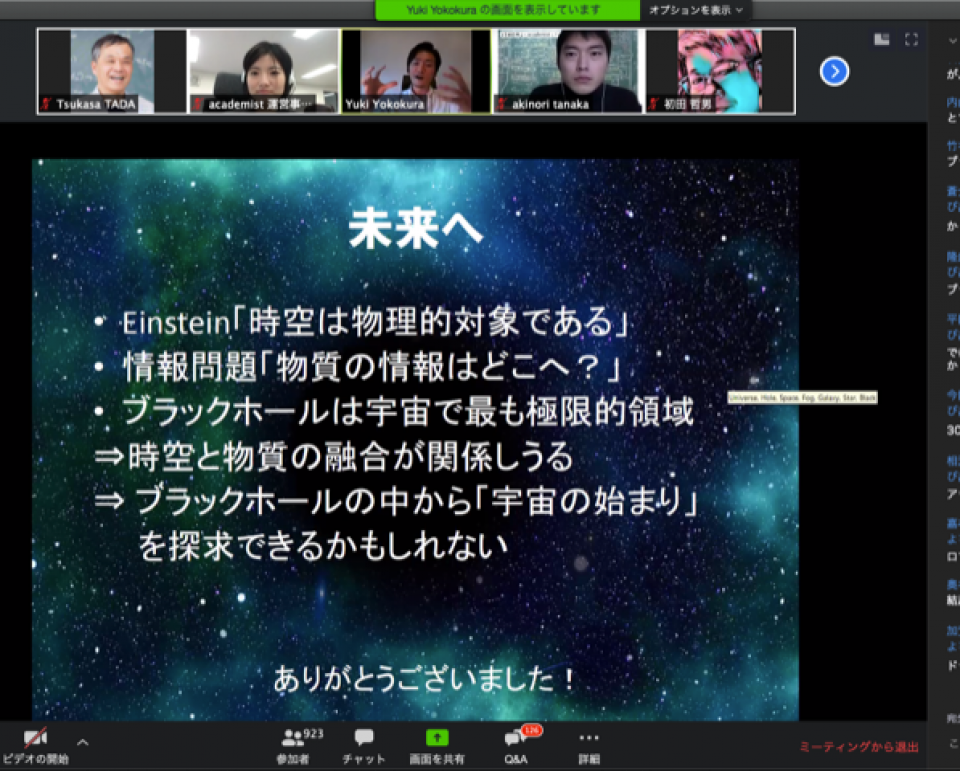Volume 100
Back to Newsletter List
Hot Topic
iTHEMS x academist Online open to the public "Mathematical science world" on April 18, 2020
2020-04-21
The open house for RIKEN was scheduled on April 18th, but it was cancelled due to the COVID-19 situation. But that did not stop Dr. Yokokura and the other lecturers, Dr. Iritani, Dr. Irie, Dr. Hiroshima, Dr. Miyazaki and Dr. Tanaka. In defiance of the difficulties, they gave the same public lecture on-line with the help by Academist.
Dr. Yokokura and other lecturers worked very hard preparing the event; their effort was rewarded by the spectacular success, with as many as over 900 viewers. Some of the positive response can be seen on Twitter.
- iTHEMS x academist Online open to the public "Mathematical science world" (in Japanese)
- iTHEMS x academist Online open to the public "Mathematical science world" Twitter Summary (in Japanese)
- academist Journal - iTHEMS特別連載 (in Japanese)
iTHEMS x academist Online open to the public "World of Mathematical Sciences"
April 18 (Sat) 10:00 - 17:00, 2020
Seminar Report
First virtual Biology Seminar on April 22, 2020
2020-04-23
Though this fiscal year started with the confusion for COVID-19, we launched virtual, iTHEMS Biology Seminar. As the first speaker of the seminar series, Asher Leeks, who is appointed with the University of Oxford and visiting Japan as IPA student, gave a talk on his own work on virus-virus interactions. Viruses may disperse (or move) between cells in a group, forming a “collective infectious unit” (CIU). If viruses can interact positively (i.e., larger CIUs enable faster replication), then CIU, albeit physiologically costly, is likely to be favored by natural selection (i.e., evolutionarily advantageous), with the result that fewer but bigger CIUs may emerge. With negative interactions, in contrast, natural selection favors smaller CIUs/no CIUs at all. This is so because, under negative interactions, forming groups would not pay. These contrasting results, therefore, suggest that understanding viral interactions may be of pivotal importance, with potential implications for clinics. He then explained genomic data for comparison and finally talked about our current collaboration project at iTHEMS. Since more and more people are now interested in virology, his new theory may give insight into a wide range of fields, and we learned a lot about what is going on within patients' bodies. Thanks for the excellent talk, Asher!
-Ryosuke Iritani (iTHEMS, Research Scientist)
Social evolution in viruses
April 22 (Wed) 10:00 - 10:45, 2020
Featured Paper of the Week
Paper: Black Hole as a Quantum Field Configuration
2020-04-20
What's going on inside black holes? The observations to date have taught us the nature of black holes outside and around it, but it does not tell us anything about the inside yet. This is because black holes are "almost" black: gravity is so strong that physical signals from the inside "almost" never come out. So, how can we search for the interior of black holes? It is necessary to return to the basic principles of physics and reconsider what a black hole is. In this paper, we succeeded in describing the inside of black holes based on general relativity and quantum mechanics (quantum field theory). What is important here is a fact that black holes evaporate: According to quantum mechanics, black holes emit weak light, slowly lose energy, and eventually evaporate (Hawking radiation). By taking in this effect from the beginning and analyzing the collapsing process of stars, we obtained the following result: The black hole is a compact object with a surface (instead of horizon) that looks like a conventional black hole from the outside and eventually evaporates without a singularity. (See figure.) Indeed, we explained why this picture can be achieved in quantum field theory. In addition, we investigated how much information is contained inside and showed that the amount (entropy) is given by the surface area. We also described how the energy decreases. This work provides the first field-theoretical formulation of the black hole, and I think it will be the basis for investigating how the information that enters the black hole will go out.
Reference:
Hikaru Kawai, Yuki Yokokura
"Black Hole as a Quantum Field Configuration"
arXiv: 2002.10331
Upcoming Events
Seminar
DMWG Seminar
Characterizing the continuous gravitational-wave signal from boson clouds around Galactic isolated black holes
April 27 (Mon) 16:00 - 17:00, 2020
Sylvia Zhu (Postdoctoral Researcher, Deutsches Elektronen-Synchrotron DESY, Germany)
Bosons such as axions or axion-like particles can form enormous clouds around black holes via the superradiance instability. As the bosons annihilate in the presence of the black hole, they produce a long-lived, slowly-evolving continuous gravitational-wave signal that is potentially detectable using the current generation of gravitational-wave interferometers.A non-detection can disfavor the existence of axions in certain mass ranges, although this is highly dependent on the Galactic black hole population. In this talk, I will discuss the expected annihilation signal from the population of isolated stellar-mass black holes in the Galaxy, and the prospects for detecting the signal using standard searches for continuous gravitational waves.
Venue: via Zoom
Event Official Language: English
Seminar
iTHEMS Biology Seminar
Analyses of large-scale sequence data from “PROTIST” can reveal the eukaryotic phylogeny and evolution
April 30 (Thu) 10:00 - 10:45, 2020
Euki Yazaki (Postdoctoral Researcher, RIKEN Interdisciplinary Theoretical and Mathematical Sciences Program (iTHEMS))
Most of the phylogenetic diversity of eukaryotes is made up of unicellular eukaryotic microorganisms called protists, some of which have not known phylogenetic home (called Orphans). Orphans are likely to hold important keys to the evolution of eukaryotes. In this seminar, I will introduce present case studies that reveal phylogenetic home and organelle evolution of orphan protists through sequence analysis based on large-scale sequence data.
Venue: via Zoom
Event Official Language: English
Paper of the Week
Week 4 of April
2020-04-23
Title: Nonadiabatic Control of Geometric Pumping
Author: Kazutaka Takahashi, Keisuke Fujii, Yuki Hino, Hisao Hayakawa
arXiv: http://arxiv.org/abs/1909.02202v2
Title: EspressoDB: A scientific database for managing high-performance computing workflow
Author: Chia Cheng Chang, Christopher Körber, André Walker-Loud
arXiv: http://arxiv.org/abs/1912.03580v2
Title: Nisnevich topology with modulus
Author: Hiroyasu Miyazaki
arXiv: http://arxiv.org/abs/1910.14579v3
Title: Dimension dependence of numerical simulations on gravitational waves from protoneutron stars
Author: Hajime Sotani, Tomoya Takiwaki
arXiv: http://arxiv.org/abs/2004.09871v1
If you would like to cancel your subscription or change your email address,
please let us know via our contact form.
Copyright © iTHEMS, RIKEN. All rights reserved.







